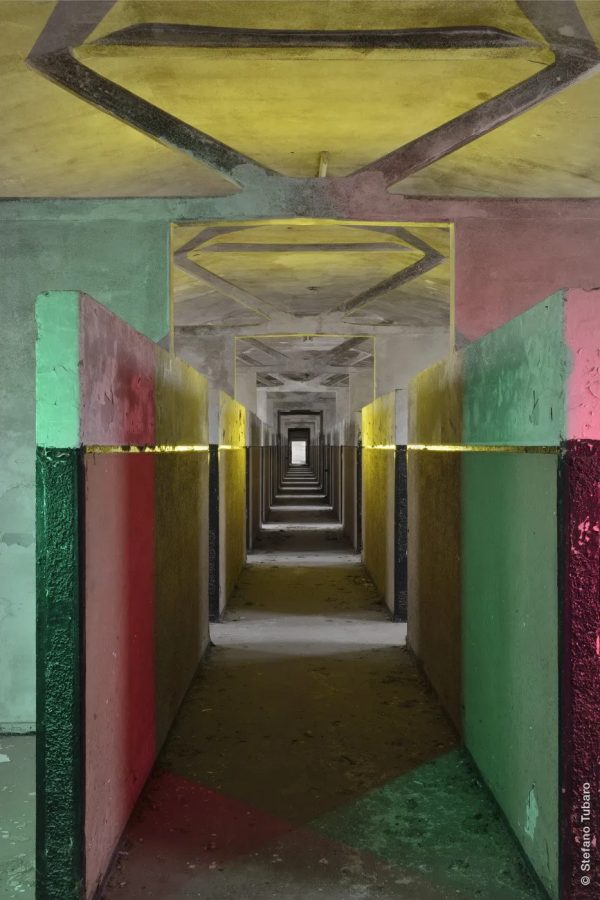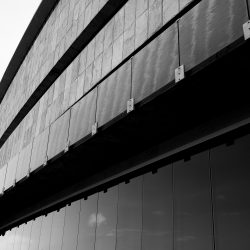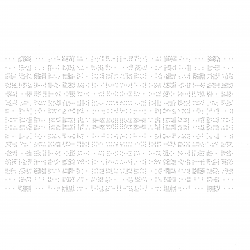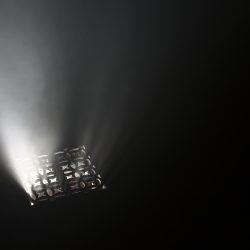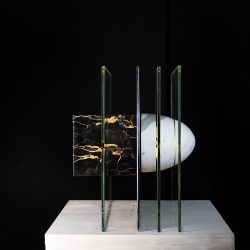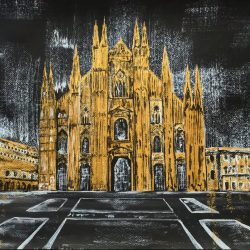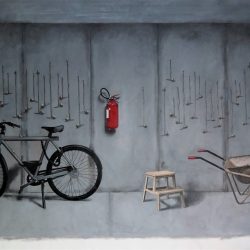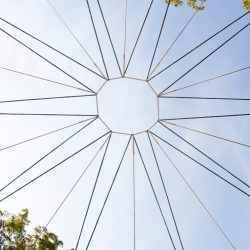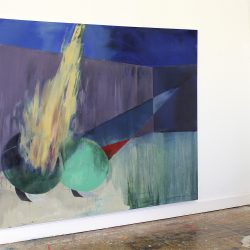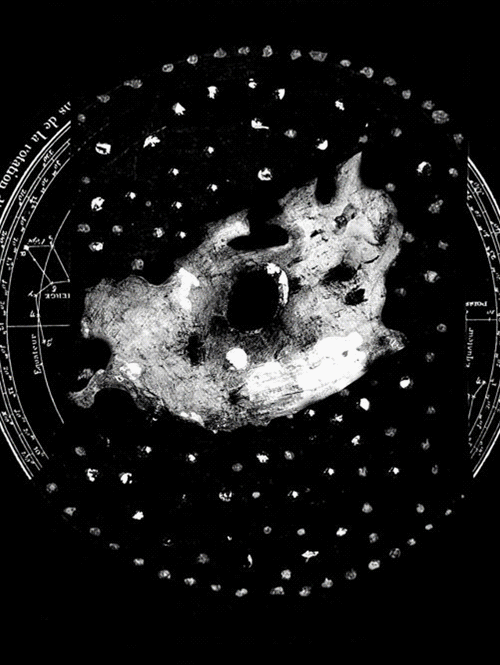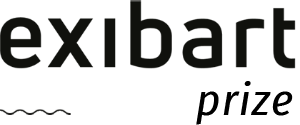work
Contrazione#0612
| category | Photography |
| subject | Architecture |
| tags | interno, spazio, disabitato, abbandonato, luce artificiale, illuminazione, architettura |
| base | 50 cm |
| height | 75 cm |
| depth | 6 cm |
| year | 2013 |
Stefano Tubaro | “Contractions” project | 2010 - 2016
•
fine art giclée pigment print on cotton paper, assembled on acid-free panel, hand-painted beech wood frame
•
The other element that photography cannot hide is the time of the shot. It is a crucial element, because it allows us to relate the image, each image, to history. It is one of the crucial elements in Stefano Tubaro's works. The subjects, in effect, are ruins, human works deteriorated by time. When we speak of ruins, we are used to considering buildings deteriorated by traumatic events, earthquakes, fires, wars, or by very long periods of time. Tubaro's ruins are of a different kind. With a few exceptions, they are recent, which suggests to us that in the times of functional building, the times of ruin have shortened. Then they show us rooms left as they were, with control panels, furniture, objects, dropped at the moment of abandonment and left there. All this, together with the abundance of artefacts photographed by Tubaro, allows us to understand how our society is singularly incapable of reusing worn-out buildings, but also of scrapping them, demolishing them. The ruins of the last industrial eras simply remain there, for years and years, in search of a reuse that rarely comes. Our barracks, built for mass conscription, have been there unused for just over ten years, and cases of reuse are the exception, not the rule. And they are already well on the way to being called ruins: a recent survey, linked to the need to relocate immigrants, revealed that usable buildings in our region can be counted on the fingers of one hand. There is a substantial inability to plan the reuse, modification, and enhancement of existing buildings: if a new need emerges, new construction is immediately thought of, and only in a very subordinate way to reuse. This is the legacy of the times when local power and the building industry supported each other, the after-effects of which we still suffer in the ideology of major works. And so buildings that are no longer in use set out on a rapid metamorphosis. From places of work and production they are on their way to becoming relics, testimonies for those who want to read them, the first step on the road to ruin status. Up to this point, Stefano Tubaro's is a documentation operation. But a glance at his works is enough to realise that it is not just that. The images are coloured, and some areas undergo a colouring that appears artificial, created and chosen by the artist. The technique is that of artificial lights filtered through coloured gelatines: a technique whose origins can be traced back to the world of entertainment, to theatre. All this creates an instantaneous short circuit: we are led, often mistakenly, to believe the photographic documentation as if it were an objective transcript, whereas the world of the stage, of theatre, is based on a complicity between actors and audience, namely the understanding that it is an event constructed by human imagination and creativity, a fiction. No one is willing to believe the theatrical truth, while many of us instinctively (we repeat, often mistakenly) take the photographic documentation as true. The artist's short circuit thus inevitably leads us to one of the fundamental themes of contemporary artistic aesthetics. We have known since the days of Greek theatre (i.e. one of the mother-strands of our culture) that fiction is not storytelling, yet it is able to take us deeper than any other expression into the depths of the human soul. In the same way, contemporary photographic aesthetics wonders whether images staged by artists are able to take us closer to the heart of things than works of documentation and testimony. There is no one answer that always applies, the strength of individual works forces us to constantly vary our judgement. Tubaro's contamination contains within itself its own specific answer.
Fabio Amodeo
(presentation text in the exhibition catalogue 'Metamorphosis of Places', Galleria Civica Tina Modotti, Udine - Colonos Cultural Association, Villacaccia di Lestizza, Udine 2016)
•
[...] But Tracce luminose will furrow the Italian cultural scene even before Milan Design Week. In Trieste, from 3 March to 4 April, in fact, the exhibition spaces of Palazzo Costanzi will host the fascinating, at times disturbing, photographic exhibition by Stefano Tubaro. Characterising the 50 works on display is the - theatrical - use of artificial light in dilapidated architectural and residential contexts. If the Contrattempi portray disused buildings pierced by psychedelic lights, the images of the Contrazioni series explore interiors, rural domestic environments or bare industrial premises. Labyrinthine room doors open onto deserted hallways and corridors. Amidst patches of multi-coloured light and deep liquid shadows, uninhabited corners can be discerned, where a few disused furnishings survive.
"[...] hanté: I resort to this French term because there is no equally appropriate and effective one in Italian," writes Ezio Sinigaglia in Sillabario all'incontrario, TerraRossa Edizioni, which, in explaining this untranslatable word, seems to describe the sensations that pervade, or perhaps arouse, Stefano Tubaro's photographic works. "Sometimes you can translate it as 'bewitched', but it does not mean bewitched: much more soberly, hanté means inhabited, but not inhabited by people or animals: inhabited in that very special and fluctuating, unlikely and unstable way, which is proper to spirits and ghosts: inhabited is too light, haunted too heavy, bewitched misleading, enchanted euphemistic, obsessed, harassed, haunted all arbitrarily derogatory". "The inhabitants of a hantée dwelling are at once light and obsessive, caressing and nagging, persecuting and enchanting: they are witches and fairies, they frighten and they give courage, they repel and they attract and, above all, they are there and they are not there," Sinigaglia concludes. Changeable and iridescent spaces, magnetic and disturbing, gloomy and at the same time astonishing, always palpitating. Like the light that inhabits them.
Claudia Foresti
(review published in 'The Book' magazine No. 16, Milan, 2023)
•
fine art giclée pigment print on cotton paper, assembled on acid-free panel, hand-painted beech wood frame
•
The other element that photography cannot hide is the time of the shot. It is a crucial element, because it allows us to relate the image, each image, to history. It is one of the crucial elements in Stefano Tubaro's works. The subjects, in effect, are ruins, human works deteriorated by time. When we speak of ruins, we are used to considering buildings deteriorated by traumatic events, earthquakes, fires, wars, or by very long periods of time. Tubaro's ruins are of a different kind. With a few exceptions, they are recent, which suggests to us that in the times of functional building, the times of ruin have shortened. Then they show us rooms left as they were, with control panels, furniture, objects, dropped at the moment of abandonment and left there. All this, together with the abundance of artefacts photographed by Tubaro, allows us to understand how our society is singularly incapable of reusing worn-out buildings, but also of scrapping them, demolishing them. The ruins of the last industrial eras simply remain there, for years and years, in search of a reuse that rarely comes. Our barracks, built for mass conscription, have been there unused for just over ten years, and cases of reuse are the exception, not the rule. And they are already well on the way to being called ruins: a recent survey, linked to the need to relocate immigrants, revealed that usable buildings in our region can be counted on the fingers of one hand. There is a substantial inability to plan the reuse, modification, and enhancement of existing buildings: if a new need emerges, new construction is immediately thought of, and only in a very subordinate way to reuse. This is the legacy of the times when local power and the building industry supported each other, the after-effects of which we still suffer in the ideology of major works. And so buildings that are no longer in use set out on a rapid metamorphosis. From places of work and production they are on their way to becoming relics, testimonies for those who want to read them, the first step on the road to ruin status. Up to this point, Stefano Tubaro's is a documentation operation. But a glance at his works is enough to realise that it is not just that. The images are coloured, and some areas undergo a colouring that appears artificial, created and chosen by the artist. The technique is that of artificial lights filtered through coloured gelatines: a technique whose origins can be traced back to the world of entertainment, to theatre. All this creates an instantaneous short circuit: we are led, often mistakenly, to believe the photographic documentation as if it were an objective transcript, whereas the world of the stage, of theatre, is based on a complicity between actors and audience, namely the understanding that it is an event constructed by human imagination and creativity, a fiction. No one is willing to believe the theatrical truth, while many of us instinctively (we repeat, often mistakenly) take the photographic documentation as true. The artist's short circuit thus inevitably leads us to one of the fundamental themes of contemporary artistic aesthetics. We have known since the days of Greek theatre (i.e. one of the mother-strands of our culture) that fiction is not storytelling, yet it is able to take us deeper than any other expression into the depths of the human soul. In the same way, contemporary photographic aesthetics wonders whether images staged by artists are able to take us closer to the heart of things than works of documentation and testimony. There is no one answer that always applies, the strength of individual works forces us to constantly vary our judgement. Tubaro's contamination contains within itself its own specific answer.
Fabio Amodeo
(presentation text in the exhibition catalogue 'Metamorphosis of Places', Galleria Civica Tina Modotti, Udine - Colonos Cultural Association, Villacaccia di Lestizza, Udine 2016)
•
[...] But Tracce luminose will furrow the Italian cultural scene even before Milan Design Week. In Trieste, from 3 March to 4 April, in fact, the exhibition spaces of Palazzo Costanzi will host the fascinating, at times disturbing, photographic exhibition by Stefano Tubaro. Characterising the 50 works on display is the - theatrical - use of artificial light in dilapidated architectural and residential contexts. If the Contrattempi portray disused buildings pierced by psychedelic lights, the images of the Contrazioni series explore interiors, rural domestic environments or bare industrial premises. Labyrinthine room doors open onto deserted hallways and corridors. Amidst patches of multi-coloured light and deep liquid shadows, uninhabited corners can be discerned, where a few disused furnishings survive.
"[...] hanté: I resort to this French term because there is no equally appropriate and effective one in Italian," writes Ezio Sinigaglia in Sillabario all'incontrario, TerraRossa Edizioni, which, in explaining this untranslatable word, seems to describe the sensations that pervade, or perhaps arouse, Stefano Tubaro's photographic works. "Sometimes you can translate it as 'bewitched', but it does not mean bewitched: much more soberly, hanté means inhabited, but not inhabited by people or animals: inhabited in that very special and fluctuating, unlikely and unstable way, which is proper to spirits and ghosts: inhabited is too light, haunted too heavy, bewitched misleading, enchanted euphemistic, obsessed, harassed, haunted all arbitrarily derogatory". "The inhabitants of a hantée dwelling are at once light and obsessive, caressing and nagging, persecuting and enchanting: they are witches and fairies, they frighten and they give courage, they repel and they attract and, above all, they are there and they are not there," Sinigaglia concludes. Changeable and iridescent spaces, magnetic and disturbing, gloomy and at the same time astonishing, always palpitating. Like the light that inhabits them.
Claudia Foresti
(review published in 'The Book' magazine No. 16, Milan, 2023)



